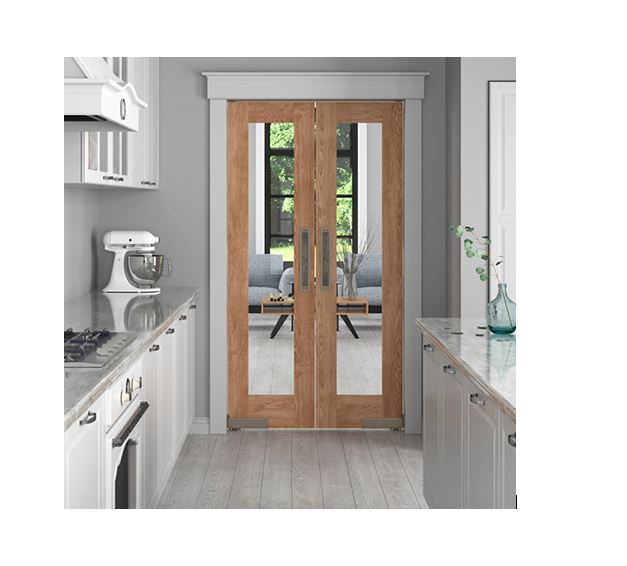
The Art of Passage: Swinging Doors in Residential Design
The Art of Passage: Swinging Doors in Residential Design

Doors are more than just entryways; they are architectural elements that mold our living spaces, directing the flow of life within our homes. When considering residential design, the type of door you choose can significantly impact everything from the aesthetics to the functionality of a space. In this post, we'll swing open the door to a world of possibilities as we explore the role that swinging doors play in modern home design.
The Evolution of Swinging Doors
Traditional Doors
Traditional swinging doors have a rich history in residential architecture, renowned for their ornate wood carvings and timeless appeal. These doors have stood the test of time, gracing the thresholds of stately homes and adding a touch of elegance to each room they protect from the elements.
Modern Innovations
The contemporary home design movement has brought with it a wave of innovation, ushering in new forms of swinging doors that prioritize clean lines and open layouts. These doors are not merely functional but serve as statement pieces that often blur the lines between interior and exterior living spaces.
Types of Swinging Doors
Panel Doors
Panel doors are a classic choice, characterized by frames filled with horizontal or vertical panels. They are versatile, complementing a range of interior styles, and provide privacy without completely closing off a space.
French Doors
French doors, with their large glass panes and double-leaf configuration, make for an airy and inviting passage between rooms. Perfect for living areas or home offices, French doors invite natural light and create a seamless transition from one space to another.
Dutch Doors
The quirky cousin of the door world, Dutch doors are divided horizontally, allowing the top and bottom halves to operate independently. They're a charming addition to kitchens and nurseries, providing the perfect combination of access and security, along with a healthy dose of character.
Swinging Doors in Interior Design
Enhancing Spaces
Swinging doors do more than just separate rooms; they define and enhance the character of interior spaces. By choosing the right door style and finishing, you can amplify the flow and feel of each area, creating a cohesive and harmonious environment tailored to your home's unique architecture.
Creating Privacy
In open-concept living spaces, swinging doors act as flexible partitions. They offer the convenience of quickly transforming the layout to accommodate different activities, from quiet reading time to bustling dinner parties without losing that desired sense of cohesiveness.
Swinging Doors in Exterior Design
Connecting with the Outdoors
Doors are portals that connect our indoor sanctuaries to the great outdoors. Swinging doors with glass panes offer an uninterrupted view of your garden or landscape, bringing the beauty of nature into your living space and creating a feeling of expansion and harmony.
Maintaining Security
While beauty and vista are important, swinging doors also serve a crucial role in safeguarding our homes. High-quality materials and secure locking systems in exterior swinging doors offer peace of mind, ensuring that your home remains a haven in every respect.
Popular Materials and Finishes
Woods of Different Grains
When it comes to choosing the right material for your swinging doors, the natural warmth and variation of wood are hard to beat. Oak, mahogany, and cherry are popular choices for their durability and the aesthetic richness they bring to the interior.
Modern Metals
For a sleek and minimalist look, consider swinging doors made from aluminum or steel. These materials are not only robust but also allow for streamlined profiles and vast expanses of glass, which are perfect for the contemporary home design aesthetic.
Choosing the Right Swinging Door for Your Home
Size and Space
The size of the door opening and the space available are critical considerations. An ill-fitting door can disrupt the balance of a room and create an awkward flow. Take accurate measurements and work with a professional to ensure a perfect fit that complements your space.
Harmony with Home Style
A traditional home may call for a solid wood panel door, while a more modern space could benefit from the clean lines of an aluminum frame with frosted glass. Every element of your home, from its architectural style to its decor, should inform your choice of door design.
Swinging Door Maintenance and Care
Regular Inspections
Periodic check-ups of your swinging doors can catch small issues before they escalate. Look for signs of wear, and ensure that hinges are well-oiled and that the door operates smoothly.
Cleaning and Restoration
Keep your swinging doors looking their best by cleaning them regularly with appropriate materials. Depending on the finish and material, this could involve a simple wipe-down with a damp cloth or, for wood doors, a gentle polish with a wood-safe cleaner.
Case Studies
Real-life examples of swinging door successes can serve as inspiration for your home design projects. From a traditional wood panel door that adds grandeur to a historic home to a sleek, modern glass door that defines an urban loft, the possibilities are endless.
Conclusion
Swinging doors are not just functional necessities in home design; they are silent actors that set the stage for the life within. Whether traditional or modern, interior or exterior, the right swinging door can transform a house into a living space perfectly tailored to the needs and desires of its inhabitants. Consider the information in this post as a starting point for your design ventures, and remember to select swinging doors that not only meet the practical requirements of your home but also resonate with your aesthetic and the space's intended purpose. Happy swinging!
